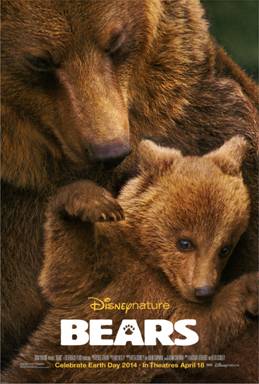Today Disneynature’s Bears is open in theaters nationwide. I’m hoping to take the girls this afternoon, if not next week since we are on school vacation.
Here are some FUN FACTS about the filming of Disneynature’s Bears I thought you may like. I found the food part pretty interesting….
LYING DOWN ON THE JOB
Principal photographers for Disneynature’s “Bears” endeavored to place moviegoers within the world of the bears by shooting all footage within a bear’s eye line. This meant positioning the cameras—and the operators—low to the ground.
LUNCHTIME
Hungry? In Katmai, you could eat a sandwich 10 feet from a bear and he wouldn’t be inclined to take a nibble. The production team—who regularly spent 12-14 hours a day out filming—was allowed to bring lunch on location. Meals never included fish—as bears would recognize this as food—but could be consumed in the presence of bears. Since these animals (unlike bears in the lower 48) have no knowledge of human food, they weren’t drawn to the scents the team’s lunch items emitted.
- Extreme caution was taken to ensure no remnants remained. Everyone was advised to eat over a re-sealable storage bag. Drop a crumb? No problem—scoop it up, sand and all, and put in your bag to be brought back to camp.
- The main camp employed strict rules regarding food so bears would not be enticed to venture into camp at night.
LOTSA FISH. LOTSA BEARS
Katmai National Park and Preserve is home to an estimated 2,000 brown bears, who are attracted to the abundance of salmon—there are five species of Pacific salmon in Katmai, including sockeye, or red salmon.
ON THE MENU
The brown bears that live in Katmai eat a variety of food (while waiting for the coveted salmon run). Bears snack on sedge grass, use their claws to pry open clams and other shellfish, munch on mussels and in late summer, will dine on ripe berries.
IT’S ALL ABOUT LAYERING
With Alaska’s unpredictable weather and shooting days that often went 14 hours, filmmakers had to plan accordingly. The key, they said, was in layering. Favorite pieces included thick thermals, waterproof jackets, chest waders, goose-down jackets and assorted t-shirts.
- Chest waders also came in handy when it came to cooling off in the river on hot days and having a dry place to sit on wet days.
SAFETY FIRST
The production team was able to film among enormous brown bears and wolves without feeling threatened thanks to the untouched area they chose to film in and the brilliant guides who accompanied them on every shoot.
- The Hallo Bay guides did not bring firearms or pepper spray during filming. Their keen sense of bear behavior helped them avoid confrontations. They did carry handheld flares, that—if triggered—would light up with a bright flame, alarming any overly interested bear (these flares have only been utilized four times in 25 years).
I’M HOME!
A brown bear’s home range can span 100 square miles.
LET SLEEPING BEARS LIE
Two filmmakers and their guide trekked to the top of a cliff to capture a wide shot of bears in the meadow. While scouting the right angle, they inadvertently interrupted a young male bear in the midst of a snooze. None too happy, the bear voiced his feelings, offered a bit of a bluff charge, and headed off to the meadow along with his girl for a bite (of sedge grass).






This was very interesting. Until now, I never really thought about what the filmmakers had to go through to create a film like this.